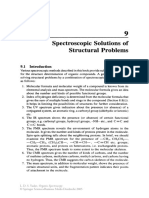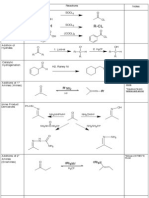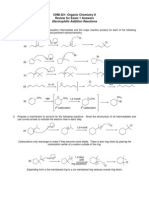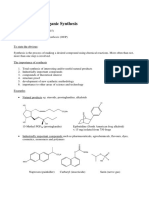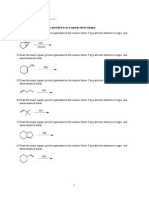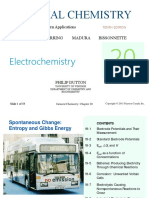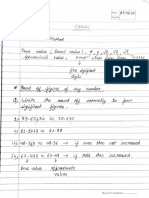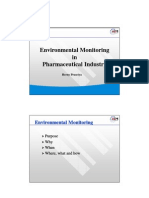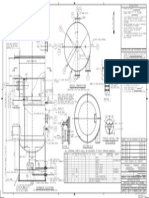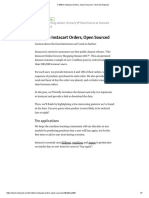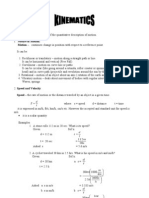Organic Chemistry II Practice Exam #2 Answer Key
Organic Chemistry II Practice Exam #2 Answer Key
Uploaded by
Quang Hiep HaCopyright:
Available Formats
Organic Chemistry II Practice Exam #2 Answer Key
Organic Chemistry II Practice Exam #2 Answer Key
Uploaded by
Quang Hiep HaCopyright
Available Formats
Share this document
Did you find this document useful?
Is this content inappropriate?
Copyright:
Available Formats
Organic Chemistry II Practice Exam #2 Answer Key
Organic Chemistry II Practice Exam #2 Answer Key
Uploaded by
Quang Hiep HaCopyright:
Available Formats
Organic Chemistry II: Practice Exam #2 Answer Key
1. Propose structures for compounds A-E in the following reaction sequence. The molecular formula for E is provided.
2. Draw structures for the products of any five (5) of the following reactions. If you answer more than five, you will receive credit for the best five.
3. We have seen several examples in which protecting a ketone as a cyclic acetal allows synthesis of hydroxy-ketones such as 1 shown below. If 1 is subsequently heated in the presence of ptoluene sulfonic acid (an acid catalyst, H+), cyclic hemiacetal 2 is produced. Propose a mechanism for the conversion of 1 into 2.
Mechanism
4. Circle the compound in each pair that will have the lower pKa (i.e. will be the stronger acid).
5. Complete one of the two following syntheses. If you do both, you will receive credit for the better one. A. Starting from 1-bromopropane and any other reagents, synthesize 2-methyl-1-pentene.
The key thing to recognize is the presence of an alkene in the final product. This should make you think of a Wittig reaction. The first step in the retrosynthesis shows how the alkene product could come from the corresponding ketone. From there, another step back involves a change of oxidation state to an alcohol. The left half of the molecule could be provided by the starting material while the right half would come from a two carbon aldehyde. The full synthesis is shown below the retrosynthesis and shows how two different carbon-carbon bond-forming reactions are combined to make the final product.
B. Perform the synthesis shown below using any necessary reagents.
This problem looks simple: you could make the organolithium reagent, add propanal, then oxidize with PCC or H2CrO4.. However, as discussed in class, the organolithium reagent would be destroyed by taking a proton from the carboxylic acid group of another molecule. Since we do not know any protecting groups for carboxylic acids, you must first convert it into something that can be protected. For example, reduction to an alcohol allows you to add a THP protecting group. You can then set out to make the new carbon-carbon bond in the product. The retrosynthesis on the next page uses the following logic: the ketone in the final product likely came from an alcohol, since we know several ways to make a new C-C bond with an alcohol as the final product, but no methods (yet!) to make a new C-C bond with a ketone as the product. At the same time, the carboxylic acid can be retrod to a primary alcohol. Thinking forwards from this point, you would use H2CrO4.to oxidize the alcohols to the required ketone and carboxylic acid.
5
The next two steps show where the new C-C bond came from: an organolithium reagent (or Grignard) at the carbon where the bromine is attached in the starting material reacts with an aldehyde to yield the secondary alcohol. Introducing the THP protecting group at the appropriate time allows the organolithium reagent to be made and reacted with the propanal. The last retro step (and first forward step) shows conversion of the carboxylic acid into something that can be protected, an alcohol.
6. Solve one of the two following problems. If you do both, I will count the one on which you do better. A. Compound 1 is converted into compound 2 by reaction with chromic acid (H2CrO4). Based on the spectral data provided below, propose structures for 1 and 2. 1 (C5H8O2): IR (1710 cm-1), 1H-NMR 9.8 (s, 1H); 2.4 (t, 2H); 2.3 (t, 2H); 2.0 (s, 3H) 2 (C5H8O3)
There are two unsaturations in both compounds. NMR information for 1 gives an aldehyde (CHO), two CH2 groups and one CH3. This leaves CO from the formula, meaning that a ketone is likely present (also indicated by the IR). This is also consistent with the chemical shifts of the methyl and methylene groups. The only way to combine the five fragments to give a structure with the proper splitting is shown above. Chemical information (oxidation with chromic acid) indicates that the aldehyde is converted into a carboxylic acid. This matches the formula. B. Compound 3 has 1H-NMR spectral data given below. Based on this information, propose a structure for 3 and also write the structure of the product (4) that would form upon reaction of 3 with CH3MgBr followed by HCl/H2O. 3 (C9H18O2): IR (1710 cm-1); 1H-NMR 9H) 4.6 (s, 2H); 3.5 (s, 3H); 2.2 (t, 2H); 1.8 (t, 2H); 1.4 (s,
There is one unsaturation in 3 and the IR data indicates that this is a carbonyl. There is no aldehyde or carboxylic acid proton in the NMR spectrum, so this is likely a ketone. However, there are two oxygens in the molecule, so the second oxygen is either present as an alcohol or an ether. There is no signal in the NMR that integrates for one proton, so it cannot be an alcohol, so the second oxygen probably has two carbons bonded to it. The NMR data indicate the presence of a tbutyl group (s, 9H), two adjacent CH2 groups (two t, 2H), and isolated CH2 (s, 2H) and CH3 (s, 3H) groups. The chemical shifts for these last two groups are downfield, so it is likely that these are adjacent to the oxygen. The structure shown for 3 matches the NMR data.
You might also like
- EXPERIMENT 5 Robinson Annulation ReactionDocument13 pagesEXPERIMENT 5 Robinson Annulation ReactionMuhammad Amirul Afifi100% (1)
- Manual Engl CoolairDocument3 pagesManual Engl CoolairPiotr Lewandowski100% (3)
- VGB-S-002-03-2016-12-EN (Public License)Document151 pagesVGB-S-002-03-2016-12-EN (Public License)karlitox123No ratings yet
- Organic Chemistry II Practice Exam #3A Answer KeyDocument8 pagesOrganic Chemistry II Practice Exam #3A Answer Keyhiep237No ratings yet
- Retrosynthetic Analysis PDFDocument6 pagesRetrosynthetic Analysis PDFHelmi FauziNo ratings yet
- Spectroscopic Solutions of StructureDocument21 pagesSpectroscopic Solutions of StructureKassimNo ratings yet
- Practice Problems-Pericyclic ReactionsDocument5 pagesPractice Problems-Pericyclic ReactionsJethro Sanz75% (4)
- IR&NMR ProblemsDocument43 pagesIR&NMR ProblemsAndrew Ronaldi Tandio100% (2)
- 123.312 Advanced Organic Chemistry: Retrosynthesis: TutorialDocument10 pages123.312 Advanced Organic Chemistry: Retrosynthesis: TutorialĐàoTrungHiếuNo ratings yet
- Asymmetric SynthesisDocument55 pagesAsymmetric Synthesisevsgoud_goud0% (1)
- Orgo Reaction SheetDocument9 pagesOrgo Reaction SheetKyle Broflovski100% (1)
- Organic Chemistry, Second Edition Janice Gorzynski Smith, ch1Document40 pagesOrganic Chemistry, Second Edition Janice Gorzynski Smith, ch1sungyeon heoNo ratings yet
- CHM 2210 Practice Exam 1Document12 pagesCHM 2210 Practice Exam 1Shaima MossamatNo ratings yet
- Neighbouring Group Participation or NGP inDocument4 pagesNeighbouring Group Participation or NGP inbharatbhushansankhya100% (1)
- AWWA M45 2nd Ed Chapter 5Document32 pagesAWWA M45 2nd Ed Chapter 5miguel medinaNo ratings yet
- DassdafDocument15 pagesDassdafEdmar Bataque100% (1)
- Organic Chemistry Ans1Document6 pagesOrganic Chemistry Ans1April NgNo ratings yet
- Practice Problems On Addition Reactions To Alkenes With AnswersDocument4 pagesPractice Problems On Addition Reactions To Alkenes With AnswersSangetha ChelladoraiNo ratings yet
- CARBONYL CONDENSATION REACTIONS 2 (10 Mei 2013)Document34 pagesCARBONYL CONDENSATION REACTIONS 2 (10 Mei 2013)Mammy Nya AllyaNo ratings yet
- Exp 11 - Aldol CondensationDocument3 pagesExp 11 - Aldol CondensationJustin BayneNo ratings yet
- Adv RetrosynthesisDocument29 pagesAdv RetrosynthesisSurya Dewi Wahyuningrum100% (1)
- Reaction Maps v1.0 - LinksDocument15 pagesReaction Maps v1.0 - LinksCATALINA FERNANDA JARAMILLO ARAYA100% (1)
- Aromaticity NotesDocument10 pagesAromaticity NotesVirendra Singh Rajput100% (1)
- Chapter 5 Elimination Reaction - 2016Document19 pagesChapter 5 Elimination Reaction - 2016Syuhadah NoordinNo ratings yet
- Retrosynthesis Practice Problems: O O OR O N O O BR O O OR 1)Document10 pagesRetrosynthesis Practice Problems: O O OR O N O O BR O O OR 1)butko88No ratings yet
- 19 Enolates EnaminesDocument59 pages19 Enolates EnaminesTwas Anassin100% (2)
- Chemistry 3719 Old ExamsDocument300 pagesChemistry 3719 Old ExamsHY-11 Đỗ Quốc Tiệp100% (1)
- Smith 4th Ed Chap 9 Alcohols, Ethers and Epoxides (Fall 2013)Document47 pagesSmith 4th Ed Chap 9 Alcohols, Ethers and Epoxides (Fall 2013)Clifford PhilogeneNo ratings yet
- Retrosynthesis SolutionsDocument7 pagesRetrosynthesis SolutionsScott Hendricks100% (2)
- Reaction SummaryDocument5 pagesReaction SummaryShafaqatRahmanNo ratings yet
- Disconnection in Organic SynthesisDocument31 pagesDisconnection in Organic SynthesisSwami Prabhu100% (2)
- 11.alkenes and Alkynesexercise PDFDocument68 pages11.alkenes and Alkynesexercise PDFMohammed Owais KhanNo ratings yet
- Protecting Groups in Organic SynthesisDocument27 pagesProtecting Groups in Organic SynthesisNur Asmi MNo ratings yet
- QOI0809 AlkenesDocument30 pagesQOI0809 Alkenesmtucker17No ratings yet
- Organic Chemistry I: The Unofficial Reaction SheetDocument11 pagesOrganic Chemistry I: The Unofficial Reaction SheetKarl WilsonNo ratings yet
- McMurry Chapter 7Document70 pagesMcMurry Chapter 7Christine TapawanNo ratings yet
- Adv Retrosynthesis PDFDocument29 pagesAdv Retrosynthesis PDFericaNo ratings yet
- Organic Exam Answer.Document11 pagesOrganic Exam Answer.S JNo ratings yet
- Chapter 12 Lecture PDFDocument156 pagesChapter 12 Lecture PDFjoseph changNo ratings yet
- Alkenes and AlkynesDocument2 pagesAlkenes and AlkynesLewis AlfonsoNo ratings yet
- Organic Reaction MapsDocument15 pagesOrganic Reaction MapsHimanshu AggarwalNo ratings yet
- Organic Chemistry 32-235 Practice Questions For Exam #2: 2. Consider The SDocument9 pagesOrganic Chemistry 32-235 Practice Questions For Exam #2: 2. Consider The Ssweta KushwahaNo ratings yet
- Organic - Lab 8 - ReductionDocument6 pagesOrganic - Lab 8 - ReductionQuynhTrang DaoNo ratings yet
- Bimolecular Nucleophilic Reaction (S) : NO NODocument5 pagesBimolecular Nucleophilic Reaction (S) : NO NObhartiyaanujNo ratings yet
- SN1 SN2Document54 pagesSN1 SN2Feby Shyntia AfirantiNo ratings yet
- Vs. E1 vs. E2 - Factors Affecting The Type of Reaction An Alkyl Halide Undergoes IncludeDocument9 pagesVs. E1 vs. E2 - Factors Affecting The Type of Reaction An Alkyl Halide Undergoes Includenikhil jalanNo ratings yet
- Chapter 1 Fundamentals of Organic ChemistryDocument5 pagesChapter 1 Fundamentals of Organic ChemistryOchem90No ratings yet
- Ch4 PDFDocument129 pagesCh4 PDFNerdalert N100% (1)
- Organic Reaction MechanismsDocument14 pagesOrganic Reaction MechanismstylerNo ratings yet
- Chapter 20 PetrucciDocument67 pagesChapter 20 PetrucciLoeyNo ratings yet
- Chapter 9 Organic Chemistry SolomonDocument6 pagesChapter 9 Organic Chemistry SolomonSukhi Sohal0% (1)
- IR - HNMR ProblemsDocument33 pagesIR - HNMR Problemsbsakaly112100% (1)
- SN1, SN2, E1, E2Document39 pagesSN1, SN2, E1, E2Dian AnggrainiNo ratings yet
- Chem 31 NotesDocument4 pagesChem 31 NotesEvernim OmpacanNo ratings yet
- ch15 Organic ChemistryDocument117 pagesch15 Organic Chemistrybrownhazel50% (4)
- Reactions of Aldehydes and Ketones: Oxidation Reduction Nucleophilic AdditionDocument51 pagesReactions of Aldehydes and Ketones: Oxidation Reduction Nucleophilic AdditionmacybnzNo ratings yet
- Exercises in Organic Synthesis Based on Synthetic DrugsFrom EverandExercises in Organic Synthesis Based on Synthetic DrugsNo ratings yet
- CHEM 331 Kraus Ihazlett 1 Chapter10Document10 pagesCHEM 331 Kraus Ihazlett 1 Chapter10Ahmed Sideeg100% (1)
- T10 QuestionsDocument20 pagesT10 Questionsleafar96100% (4)
- The Alkane Series: Formula Name Displayed Formula Condensed Formula CH Methane CHDocument7 pagesThe Alkane Series: Formula Name Displayed Formula Condensed Formula CH Methane CHpasser byNo ratings yet
- F324 June 2013 Unofficial Mark SchemeDocument7 pagesF324 June 2013 Unofficial Mark SchemearyoaudittNo ratings yet
- Aldehida Dan KetonDocument88 pagesAldehida Dan KetonSITI FARAS RAHMAWATI 2021No ratings yet
- Nomenclature of AlcoholsDocument7 pagesNomenclature of AlcoholsJuselle Faith AtaNo ratings yet
- Organic Chemistry 2Document5 pagesOrganic Chemistry 2ibdpNo ratings yet
- DOR-230 PCB #1 Signal Input Error: Point of Detection ApplicationDocument1 pageDOR-230 PCB #1 Signal Input Error: Point of Detection ApplicationDaniel GatdulaNo ratings yet
- M CLeaner LogDocument15 pagesM CLeaner LogSPEditzNo ratings yet
- Thesis On Deep DrawingDocument8 pagesThesis On Deep Drawingcarolinacardonapaterson100% (2)
- Sample Math Teacher ResumeDocument2 pagesSample Math Teacher ResumeCalypso Man100% (1)
- Masterclass - Ducting - Equal Friction Method Part 30Document11 pagesMasterclass - Ducting - Equal Friction Method Part 30T Satheesh Kumar100% (1)
- Single Case Research DesignDocument10 pagesSingle Case Research DesignDashMadNo ratings yet
- Statical Math 1Document25 pagesStatical Math 1LAB SCIENCENo ratings yet
- Student Handout 3 How To Assemble and Disassemble PCDocument12 pagesStudent Handout 3 How To Assemble and Disassemble PCLemuel Condes88% (8)
- ADSS Cable AccessoriesDocument7 pagesADSS Cable AccessorieskingoglobalNo ratings yet
- 2nd Term Physics ReviewerDocument5 pages2nd Term Physics ReviewerAlfredo L. CariasoNo ratings yet
- Environmental MonitoringDocument27 pagesEnvironmental MonitoringHerry Supriatna100% (2)
- Nuclear Pump SeismicDocument11 pagesNuclear Pump SeismicClydeUnionNo ratings yet
- Design Notes: 001 D M88 DB-950009 00Document1 pageDesign Notes: 001 D M88 DB-950009 00raobabar21No ratings yet
- Course Syllabus: College of Arts and Sciences EducationDocument10 pagesCourse Syllabus: College of Arts and Sciences EducationAsru RojamNo ratings yet
- Instacart Dataset ArticleDocument7 pagesInstacart Dataset ArticleThảo ĐặngNo ratings yet
- Layers of The EarthDocument29 pagesLayers of The EarthfloridohannahNo ratings yet
- 4G Magic Communication: Author:Alekhya .CH III/IV B.Tech (E.C.E) Email Id:allu - Smile04@yahoo - inDocument9 pages4G Magic Communication: Author:Alekhya .CH III/IV B.Tech (E.C.E) Email Id:allu - Smile04@yahoo - inSowjanya DaliparthiNo ratings yet
- Pentatonic Harmony BookletDocument17 pagesPentatonic Harmony BookletDavid Ramos Torres100% (2)
- Ch. 5 KinematicsDocument11 pagesCh. 5 KinematicsJoanne Aga EslavaNo ratings yet
- Day 17Document9 pagesDay 17Dawood urineNo ratings yet
- Working Capital Management andDocument15 pagesWorking Capital Management and155- Salsabila GadingNo ratings yet
- Fundamentals of Numerical Reservoir SimulationDocument57 pagesFundamentals of Numerical Reservoir SimulationJamaluddin100% (1)
- Hydron PVC BrochureDocument28 pagesHydron PVC BrochureNitesh SuhagNo ratings yet
- 30 Projects Using Fat QuartersDocument44 pages30 Projects Using Fat Quarterseugenia chirita100% (2)
- Telling Compelling Stories With Numbers PDFDocument99 pagesTelling Compelling Stories With Numbers PDFJuYoung LimNo ratings yet
- Atlas MilitaryDocument12 pagesAtlas MilitaryRasoolKhadibi100% (1)





